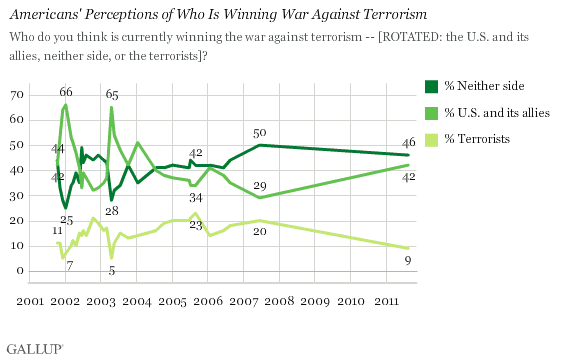PRINCETON, NJ -- Americans' views on who is winning the war on terrorism are almost identical now to where they were in October 2001. Americans are roughly evenly split, 46% to 42%, between the view that the U.S. and its allies are winning the war on terrorism and the view that neither the U.S. nor the terrorists are winning. Despite the similarity between views now and 10 years ago, there has been a great deal of change in the intervening time, including points in 2002 and 2003 when two-thirds of the public felt that the U.S. was winning.

Ten Years of Wavering Opinion
Gallup's initial reading on this measure came in October 2001, shortly after U.S. military action in Afghanistan commenced, when 42% of Americans said the U.S. and its allies were winning the war, 44% said neither side was winning, and 11% said the terrorists were winning.
From November 2001 through March 2002 a majority of Americans said that the U.S. was winning the war on terrorism, including an all-time high of 66% in January 2002. By the spring of 2002, however, these more positive perceptions dwindled -- at times in June and again in the fall, approximately one-third said the U.S. was winning.
Positive perceptions picked up again in April 2003, this time coincident with the U.S. invasion of Iraq. Sixty-five percent of Americans at that point said that the U.S. was winning the war on terrorism. These positive sentiments were, again, short-lived. By the summer of 2003, perceptions that the U.S. was winning fell below the majority level -- where they have remained since, with the exception of one survey reading in January 2004. An all-time low of 29% of Americans said the U.S. was winning the war on terrorism in June 2007.
Gallup did not ask the question after 2007 again until this August, and the current 42% of Americans who believe the U.S. is winning matches the average reading across the 31 times the question was asked. The average view that neither side is winning has been 40%, putting the current "neither" view slightly above average.
The 9% who believe that the terrorists are winning is among the lowest reading on that measure since 2001. The highest point for this belief was 23% in August 2005.
The uncertainty among many Americans that the U.S. is winning the war on terrorism is underscored by the finding that about 6 in 10 Americans believe that terrorists will always find a way to launch major attacks on the U.S. no matter what the U.S. government does. This is virtually unchanged from September of 2002.

Bottom Line
Americans' views of the war on terrorism are in an almost identical position to where they were in October of 2001, a month after the Sept. 11 terrorist attacks on New York City and Washington, D.C., and just after the war in Afghanistan began. The public remains essentially split on the issue of whether the U.S. and its allies are winning, or whether neither side is winning the war, with few holding the belief that the terrorists are winning.
This lack of change from the beginning and end of the decade masks a great deal of movement on this measure as the 10 years unfolded, including two points in time when the public became significantly more positive about winning the war on terrorism -- about a month into the war in Afghanistan in 2001, and at the beginning of the Iraq war in March 2003. The majority of Americans remain convinced that terrorists can always manage to launch attacks on the U.S. if they want to, regardless of what the U.S. government may do.
Survey Methods
Results for this Gallup poll are based on telephone interviews conducted Aug. 11-14, 2011, with a random sample of 1,008 adults, aged 18 and older, living in the continental U.S. selected using random digit dial sampling.
For results based on the total sample of national adult, one can say with 95% confidence that the maximum margin of sampling error is ±4 percentage points.
Interviews are conducted with respondents on landline telephones and cellular phones, with interviews conducted in Spanish for respondents who are primarily Spanish-speaking. Each sample includes a minimum quota of 400 cell phone respondents and 600 landline respondents per 1,000 national adults, with additional minimum quotas among landline respondents for gender within region. Landline telephone numbers are chosen at random among listed telephone numbers. Cell phones numbers are selected using random digit dial methods. Landline respondents are chosen at random within each household on the basis of which member had the most recent birthday.
Samples are weighted by gender, age, race, Hispanic ethnicity, education, region, adults in the household, and phone status (cell phone-only/landline only/both, cell phone mostly, and having an unlisted landline number). Demographic weighting targets are based on the March 2010 Current Population Survey figures for the aged 18 and older non-institutionalized population living in U.S. telephone households. All reported margins of sampling error include the computed design effects for weighting and sample design.
In addition to sampling error, question wording and practical difficulties in conducting surveys can introduce error or bias into the findings of public opinion polls.
For more details on Gallup's polling methodology, visit https://www.gallup.com/.
